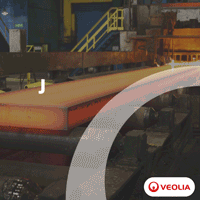OECD-IISI Conference Participants See Bright Outlook for 05-06 Steel Industry
01/20/2005 - Industry and government officials met January 12-13 at a Paris conference organized by the OECD and the International Iron and Steel Institute. The participants, representing economies accounting for over 95% of crude steel production, confirmed the need for continued dialogue on developments and emerging issues in the industry. Participants expect the current buoyant market conditions in steel to continue throughout 2005 and into 2006.
Industry and government officials met January 12-13 at a Paris conference organized by the OECD and the International Iron and Steel Institute. The participants, representing economies accounting for over 95% of crude steel production, confirmed the need for continued dialogue on developments and emerging issues in the industry. Participants expect the current buoyant market conditions in steel to continue throughout 2005 and into 2006.
Participants heard how the strong market has boosted financial performance in the sector and has sparked interest in new steelmaking capacity. Improved market and financial conditions have helped to facilitate consolidation in the industry, which still remains highly fragmented. The conference revealed continued concern over government subsidies and widespread interest in an international agreement that would strengthen disciplines in this regard.
Participants also discussed market developments at the global level and in major regions. Principal points follow:
- The steel market was exceptionally buoyant in 2004, with global steel consumption growing 8.8% over the 2003 level to reach some 935 million tonnes of finished products. In the OECD area, steel demand increased by 7.5% or 22 million tonnes over the previous year. The strongest increase in apparent steel consumption was recorded in North America (+15%), while for the rest of the OECD apparent consumption increased by some 3.4%. In the N.I.S. area steel consumption increased by 13.5%, while in China the increase was close to 11%, representing some 25 million tonnes more than in 2003.
- Crude steel production also showed remarkable growth and at world level passed the 1 billion tonne mark for the first time in history, an increase of 84 million tonnes compared to 2003. In China, production increased by a further 22.5%, reaching 270 million tonnes.
- World trade in steel increased in volume terms by 4.4% and reached a new record level at 263 million tonnes in 2004; it represented 28% of world steel consumption. However, major changes took place in trade flows, with OECD net steel exports dropping by more than 60%. The other major change reported was the strong decline in steel imports by China (-24%), while at the same time Chinese steel exports doubled to over 17 million tonnes.
- Prices for steel products increased sharply and rapidly in 2004, helping the industry to return to strong profitability, despite related increases in raw material and transportation costs.
Participants also discussed their views regarding the short-term future, concluding that the outlook for 2005 remains good. Participants base their outlook on the following projections:
- World steel demand should continue to grow by some 5%, driven by the continuing strong growth in demand in China where steel consumption is expected to increase by another 10.7%. Growth in consumption should continue in the N.I.S. (newly independent states of the former Soviet Union) as well as in many non-OECD market economies, while the OECD area will record more mixed results between Member countries even if for the area as a whole a 2% growth may be expected.
- Crude steel production should also grow in 2005 and in 2006 when China, with an expected 340 million tonnes, will represent 30% of world production.
- Trade in steel is expected to start declining as from 2005 as a result of important additions of new capacity, particularly in China, India and other Asian economies.
- Global crude steelmaking capacity is expected to increase from 1184 million tonnes per year in 2004 (when the average capacity utilization rate was above 88%) to over 1305 million tonnes per year in 2006.
Despite the present positive short-term market outlook, three areas of concern were mentioned. These concerned (i) significant new steel capacity expansion; (ii) conditions in raw material markets; and (iii) potentially large shifts in steel trade flows. It was noted that a further crisis in steel could arise in several years time, should capacity expansion exceed market needs by a significant amount. It was also noted, however, that the potential for further market growth in China, India, Latin America and the NIS was great; if such growth materialized, it could -- barring economic shocks -- be sufficient to avoid such a crisis.
Sustainable development issues are being addressed forcefully by the industry. Working through the International Iron and Steel Institute, companies have developed a series of industry-specific criteria for measuring economic, environmental and financial performance.
Concerns were expressed that the uneven introduction of measures to reduce greenhouse gas emissions by countries worldwide had the potential to significantly affect competition between companies in countries subject to taxes and/or emissions restrictions, and those that were not. There was hope that the industry and governments might be able to explore a more global sectoral approach that would minimize distortions in competition, while contributing more effectively to global greenhouse gas objectives. In this latter context, it was pointed out that while steel production was part of the problem due to its reliance on coal and coke, it was also an important part of the solution for many steel-consuming industries that were also facing sustainability challenges.
The sharp price increases and, in some instances, shortages that occurred in three key raw materials (iron ore, coking coal and coke) were seen as easing. In the case of iron ore and coking coal and coke, investment in new capacity were taking place, with prices expected to settle at levels that would still be higher than those prevailing several years ago. In the case of scrap, prices were also expected to ease, but at structurally higher levels, leading to renewed interest in ore-based complements, such as sponge iron. The situation in transportation was also expected to ease, as seaborne capacity was increasing.
Industry consolidation was expected to continue to take place, as enhanced financial strength helps to facilitate more active exploration of mergers and acquisition. Consolidation was considered an important development that should help the industry to weather cyclical downturns more effectively. Although considerable consolidation has already taken place, the industry remains highly fragmented at the global level, with the ten largest producers accounting for only about 30% of total world steel production. Concern was expressed, however, that smaller producers, competitive as they might be, might not be able to remain as stand-alone operations.
There was general agreement that steel issues continued to pose difficult challenges for governments in various respects, and that a continued dialogue, with industry participation, would be beneficial. It was hoped that all major steel-producing economies would continue to take part in any further activities in this regard.
A number of delegates expressed concern over the subsidies that some governments continue to provide for companies to expand steelmaking capacity. Support for an agreement that would strengthen multilateral disciplines on such subsidies remains strong. Efforts to achieve consensus on the scope and some key elements of an agreement continue. The OECD, which is a unique forum to facilitate such an agreement, is currently working with parties to advance the talks.



-(220-x-200-px)-(130-x-130-px)-(220-x-200-px).jpg?lang=en-US&ext=.jpg)
Veolia.gif?width=200&height=200&mediaprotectionhash=4deca34a0d5a00013b5a0ccdc2dcf98fd2c17aabb57eb7bbb27200552f29c247&ext=.gif)





